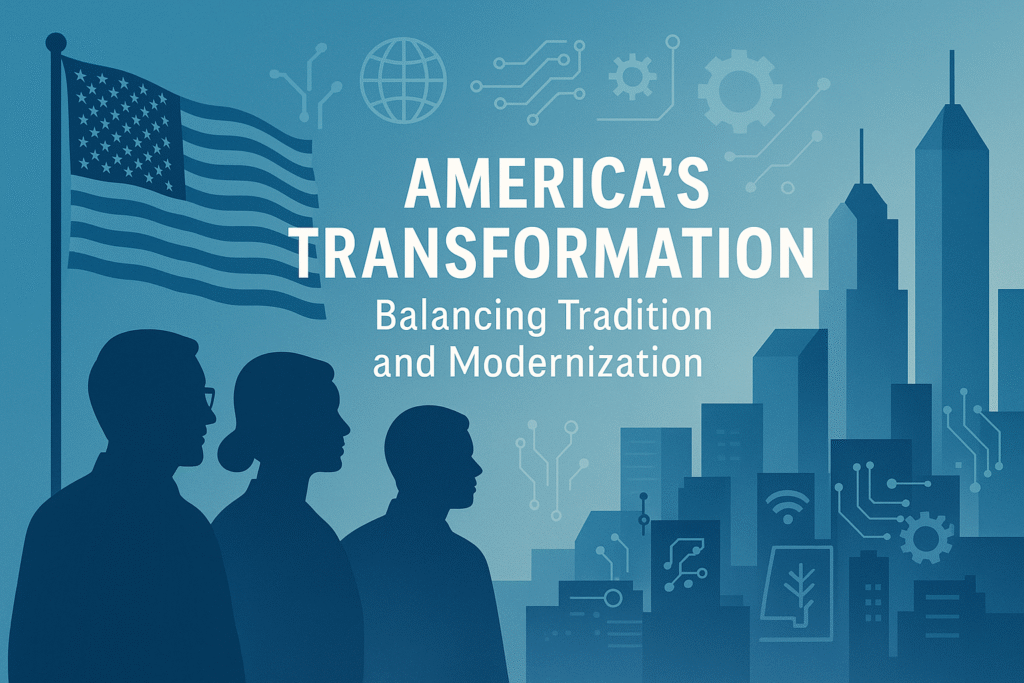Policy Paper
America’s Transformation: Balancing Tradition and Modernization in 2025
Executive Summary
The United States, like the Middle East, faces a fundamental challenge: how to modernize without losing identity. Polarization, rapid technological disruption, and cultural debates are reshaping America’s transformation trajectory.
This paper explores how the U.S. can balance tradition (democracy, constitutional values, cultural heritage, community life) with modernization (AI, renewable energy, social reforms, global competitiveness). Lessons from the Middle East—particularly Saudi Arabia’s Vision 2030 and the UAE’s knowledge economy strategies—offer useful insights for America’s future.
Table of Contents
-
Introduction: Why Balance Matters for the U.S.
-
Defining Tradition and Modernization in the American Context
-
Drivers of America’s Transformation
-
Lessons from the Middle East for the U.S.
-
U.S. Case Studies in Balancing Tradition & Modernization
-
Traits of Transformational American Leaders
-
Enablers: Institutional, Cultural, and Economic Foundations
-
Barriers and Risks Facing the U.S.
-
Policy Recommendations: Blueprint for America
-
Conclusion
1. Introduction: Why Balance Matters for the U.S.
America has long seen itself as a beacon of progress and tradition. Yet today, it faces a paradox: how to embrace modernization—AI, renewable energy, social reform—without alienating deeply rooted traditions such as democratic governance, religious freedom, and community identity.
Failure to strike this balance risks worsening polarization and weakening global leadership. As with the Middle East, a balanced transformation is essential for stability and legitimacy.
2. Defining Tradition and Modernization in the American Context
-
Tradition in the U.S.: Constitutional democracy, religious freedom, community institutions, historical heritage.
-
Modernization in the U.S.: Digital economy, clean energy transition, AI and automation, evolving social norms, global leadership role.
-
Transformation: Integrating both—modernizing infrastructure and institutions while preserving America’s cultural and democratic roots.
3. Drivers of America’s Transformation
-
Technological disruption: AI, robotics, biotechnology, and digital infrastructure.
-
Climate imperatives: Renewable energy adoption, electric vehicles, climate resilience.
-
Equity debates: Addressing racial, gender, and income inequality.
-
Polarization: Divisions between rural/urban, religious/secular, traditional/modern.
-
Global competition: China and Europe advancing energy, AI, and governance models.
4. Lessons from the Middle East for the U.S.
-
Strategic Vision: Saudi Arabia’s Vision 2030 shows the power of long-term planning—America could benefit from a bipartisan “Vision 2050” for modernization.
-
Knowledge Economy Investment: The UAE’s push into innovation highlights the need for the U.S. to invest more in R&D and workforce training.
-
Heritage Preservation: Gulf states balancing skyscrapers with cultural conservation reminds America to invest in protecting rural traditions, Indigenous cultures, and civic institutions.
-
Gradual Social Reform: The Middle East shows that reforms succeed when introduced gradually and inclusively—critical for U.S. debates on social issues.
5. U.S. Case Studies in Balancing Tradition & Modernization
-
Operation Warp Speed (2020–21): Combined scientific modernization with traditional federal leadership structures.
-
The Inflation Reduction Act (2022): Modernizing energy while balancing political traditions of federalism and state innovation.
-
Appalachia Transition Programs: Retraining coal workers for clean energy while respecting regional identities.
-
Indigenous Renewable Energy Projects: Integrating modernization with Indigenous sovereignty and cultural values.
6. Traits of Transformational American Leaders
-
Bridge-builders: Able to navigate partisan divides.
-
Inclusive visionaries: Bringing rural, Indigenous, and minority voices into modernization debates.
-
Historically rooted innovators: Leaders who connect constitutional traditions with new reforms.
-
Resilient in crises: Capable of navigating pandemics, climate disasters, and polarization.
7. Enablers: Institutional, Cultural, and Economic Foundations
-
Strong constitutional framework and checks & balances.
-
Higher education and innovation ecosystems.
-
Civil society and grassroots movements.
-
Federal funding (e.g., Infrastructure Act, IRA).
-
Private sector leadership in technology and energy.
8. Barriers and Risks Facing the U.S.
-
Polarization undermining reform legitimacy.
-
Inequality in modernization benefits (urban vs rural, rich vs poor).
-
Distrust in government (only 27% of Americans trust federal government, per Gallup, 2024).
-
Short-termism from election cycles and market pressures.
-
Resistance to change from communities fearing loss of tradition.
9. Policy Recommendations: Blueprint for America
-
Launch a bipartisan “Vision 2050”—a long-term modernization plan.
-
Invest in knowledge economy capacity (AI, green jobs, R&D).
-
Expand just transition programs for fossil fuel-dependent regions.
-
Preserve traditions alongside modernization—fund cultural heritage, civic education, community resilience.
-
Create inclusive reform councils—bringing in rural, Indigenous, religious, and minority voices.
-
Accelerate modernization infrastructure (grids, broadband) while embedding equity.
-
Strengthen trust with transparent, participatory governance.
10. Conclusion
From my five decades of transformation analysis, I can say with confidence: America’s strength lies in its ability to balance change with continuity. The Middle East shows the risks of ignoring tradition, and the opportunities of blending it with modernization. For the U.S., transformational leadership in 2025 means investing in innovation, embedding equity, and preserving the cultural and democratic traditions that anchor legitimacy.
If America gets this balance right, it will not only modernize sustainably but also reassert its role as a model of transformation for the world.
References
-
Gallup (2024). Trust in Government Remains Near Historic Lows. (gallup.com)
-
White House (2022). Inflation Reduction Act. (whitehouse.gov)
-
Institute for Global Change (2023). Modernisation in the Middle East. (institute.global)
-
ResearchGate (2022). Beyond Tradition and Modernity: Saudi Arabia’s Transformation. (researchgate.net)
Check out the GTF Research
Check out events
Connect with us on facebook
connect with us on linkedIn
Check out the American Transformation forum
